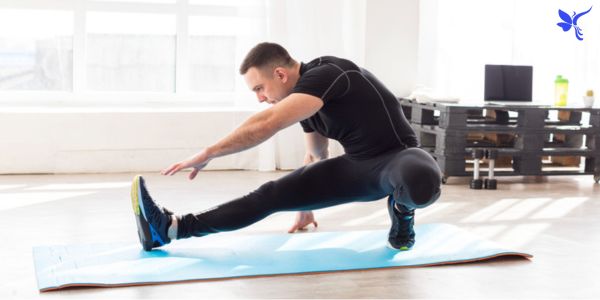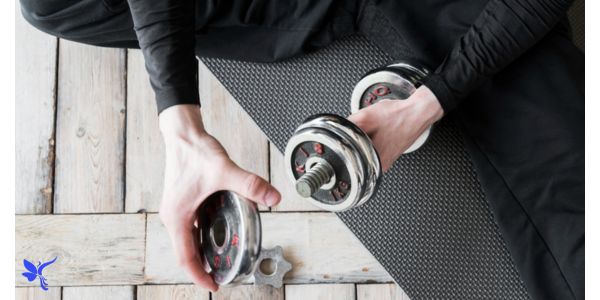For many dedicated athletes, the thought of a running break can feel like a setback, a forced pause in their fitness journey. Whether sidelined by an injury, needing surgery recovery, or simply seeking a smart way to manage aches and pains, stepping away from high-impact activities doesn’t mean sacrificing your hard-earned aerobic fitness. The good news is that maintaining, and even enhancing, your physical well-being is entirely possible without putting stress on vulnerable joints.
This comprehensive guide unveils the powerful world of Non Weight Bearing Exercises, offering expert tips and strategies to keep you strong, resilient, and ready for your return, ensuring your body heals while your fitness momentum soars.
Understanding Non Weight Bearing Exercises
Discovering what Non Weight Bearing Exercises truly entail is the first step toward maintaining your fitness during a running break. These activities are specifically designed to allow you to exercise without placing any significant stress (on body parts) or direct weight on your lower limbs. This means your feet or legs are not supporting your body weight, making these exercises ideal for individuals recovering from injuries, surgeries, or other medical conditions that restrict weight-bearing activities.
The fundamental principle behind Non Weight Bearing Exercises is to keep your body active and engaged, promoting circulation (blood) and preserving muscle strength, all while protecting vulnerable areas. These activities (types) prevent muscles from becoming tight or short after an injury, which is vital for a seamless healing process. Imagine continuing your training without worrying about aggravating a stress fracture or a tendon rupture; that is the transformative power of this approach.
Why Non Weight Bearing Exercises is Essential for Runners
Even the most dedicated collegiate runner understands that a running break is sometimes inevitable. For runners, Non Weight Bearing Exercises isn’t merely a substitute; it’s a crucial strategic component for long-term athletic longevity. It allows your body to mend and recover without losing the hard-earned cardiovascular health and endurance that define your sport. This intelligent approach safeguards your future running performance.
Think of it as an active recovery that builds a stronger foundation. By engaging in Non Weight Bearing Exercises, you can prevent muscle atrophy and maintain muscle strength in other parts of your body. This ensures that when you are cleared to run again, your return to the pavement is much smoother, reducing the risk of re-injury and enhancing your overall resilience. It’s about being proactive in your recovery, not just waiting it out.
Identifying When to Prioritize Non Weight Bearing Activities
Recognizing the Signals for a Rest

Recognizing when your body is signaling for a break is paramount for both injury prevention and effective recovery. Often, runners can push through various aches and pains with diligent TLC (tender loving care), although consulting a doctor to ensure continued running is safe is always prudent. However, certain injuries (specific types) definitively demand time off.
Stress fractures represent the most common reason runners are sideline runners for extended periods. Anh Bui, a Physical Therapist (PT) and biomechanics specialist, highlights these as critical indicators. Tendon ruptures, usually partial, are another significant cause, often requiring immobilization or even surgery recovery. The duration of your running break varies greatly with the injury’s nature and severity. For instance, a tibia fracture might necessitate six to eight weeks of rest, while a femoral neck fracture could demand 12 to 16 weeks, emphasizing the need for an MRI (Magnetic Resonance Imaging) to determine severity and location. Adhering strictly to your doctor’s recommended time off is non-negotiable; running on a stress fracture too soon risks delaying and complicating the entire healing process.
Benefits of Incorporating Non Weight Bearing Exercises into Your Routine

Unlocking the myriad advantages of these low-impact activities (types) can revolutionize your fitness journey, especially during a forced running break. Non Weight Bearing Exercises offer a safe haven, preserving your cardiovascular health and maintaining muscle mass without any detrimental impact (on joints). This broad spectrum of positive effects extends beyond mere injury recovery.
| Benefit Category | Specific Advantages |
| Cardiovascular Health | Maintains aerobic fitness, increases heart rate without putting unhealthy stress on your body. |
| Muscle Preservation | Prevents muscle atrophy, builds muscle endurance, and tones muscle groups. |
| Injury Recovery | Facilitates healing process, promotes circulation (blood), and ensures smoother recovery process. |
| Mental Well-being | Helps manage stress management, improves sleep, and offers a sense of control over fitness. |
| Flexibility & Balance | Increases flexibility, improves balance, and maintains range of motion. |
These exercises provide a pathway to continued physical engagement, allowing you to focus on core strength, flexibility, and balance without aggravating an existing injury. They help prevent muscles from becoming tight or short after an injury, ensuring that when you return to full activity, your body is better prepared and more resilient.
How to Choose the Right Non Weight Bearing Exercises for You
Selecting the ideal Non Weight Bearing Exercises during your running break hinges on several factors: the nature of your injury, your personal preferences, and the resources available to you. While many options can keep you in excellent aerobic fitness without joint strain, the “best” activity is truly subjective. Consider what you genuinely enjoy; if a particular activity feels like a chore, consistency will suffer.
For example, if you have access to a pool, aqua jogging is often the top recommendation from experts like Gaudette. It closely mimics the posture and movements of dry-land running, providing an intense full-body workout without any impact (on joints). However, if pool access is logistically difficult or you simply dislike it, a stationary bike or a mini exercise bike could be a fantastic alternative, allowing you to engage in effective seated cycling. Remember, the ultimate goal is consistent engagement, so choose an activity that motivates you to move.
Top Non Weight Bearing Cardio Exercises

Engaging your cardiovascular system without jarring impact (on joints) is entirely achievable with the right Non Weight Bearing Exercises. These activities are designed to elevate your heart rate, boosting your aerobic fitness and endurance while your body heals. They are excellent substitutes for maintaining your cardio capacity during a running break.
- Aqua Jogging: This involves mimicking running motions in deep water, often with a flotation belt. The water’s resistance of the water provides a challenging workout for your muscle groups while eliminating gravity’s impact. It’s a fantastic full-body workout that maintains running form.
- Seated Cycling: Whether on a traditional stationary bike or a mini exercise bike, seated cycling offers a superb cardiovascular challenge. A 2018 study in the Journal of Strength and Conditioning Research even found that cycling improved running performance and hip extensor strength in high-school runners. Just remember to stay seated; standing on the pedals reintroduces weight-bearing.
- Swimming: An exceptional full-body workout, swimming offers significant swimming benefits by increasing your heart rate without unhealthy stress on your body. Different swimming strokes target various muscle groups, building endurance and toning muscles. This also proves beneficial for calming stress and can contribute to reducing both blood pressure and blood sugar levels.
- Rowing: Using a rowing machine provides a fantastic full-body workout that is completely non-weight-bearing. It engages your legs, core, and upper body in a fluid, low-impact motion, building both cardiovascular health and muscle strength.
- Arm Cycling (Hand Biking): This targets the upper body, specifically the arms, shoulders, and upper back. Using a stationary arm cycle machine, you can adjust resistance levels to focus on building muscle strength or enhancing cardiovascular endurance. It’s an excellent way to maintain aerobic fitness for individuals with lower limb injuries.
Top Non Weight Bearing Strength and Resistance Exercises
Strengthening your physique from head to toe using methods that spare your joints is crucial for a complete recovery process during a running break. These non weight bearing resistance exercises are carefully designed to build muscle strength and endurance without placing undue stress on healing areas.
- Seated Arm Exercises: You can perform these with dumbbells or resistance bands. Seated bicep curls target the front of your upper arms, while tricep dips (using a sturdy chair) work the back. These elements are crucial for keeping up your upper body exercises and building muscle strength.
- Seated Leg Exercises: Even when off your feet, you can engage your leg muscles. Seated leg extensions strengthen your quadriceps, and seated leg circles improve hip flexibility and range of motion. Such delicate actions both guard against muscle atrophy and support healthy circulation (blood).
- Upper Body Focus: Beyond specific arm exercises, consider movements like dumbbell chest press (lying or seated), bent-over seated row to target your back, and dumbbell shoulder press. For added versatility, chest flies with a cable and seated lateral raise can isolate muscle groups effectively. Tricep extensions also offer excellent arm conditioning.
Core-Specific Non Weight Bearing Exercises
A robust core strength is the cornerstone for any athlete, providing stability and power for everyday movements and future running endeavors. Even while recovering from a lower body injury, you can effectively train your core with Non Weight Bearing Exercises. These movements strengthen your abdominal and back muscles without putting any stress on your legs or feet.
For instance, seated Russian twists engage your obliques and rectus abdominis as you twist your torso from side to side, often with feet slightly lifted. Seated knee tucks are another excellent option; by bringing your knees towards your chest while seated, you activate your lower abdominal muscles. These seated core exercises are vital for maintaining posture, balance, and overall trunk stability, ensuring your core remains a powerhouse throughout your running break.
Integrating Non Weight Bearing Cross-Training into Your Schedule
Seamlessly weaving non weight bearing cross-training into your weekly regimen is key to maintaining fitness momentum during a running break. The strategy is surprisingly straightforward: look at your typical running calendar (scheduling). Pencil in the runs you would normally be doing, noting the mileage or time and the intensity (e.g., an easy run versus a sprint workout).
Next, go back over those days and mark in the non weight bearing activities you will do in place of each run. Aim to move for the same amount of time you would have spent on your feet and strive to hit the same effort level. For example, if you typically run for an hour four days a week, with one session being a harder effort, you would apply the same principle to your cross-training. Most individuals can adapt to this new regimen quickly, often jumping into it effectively from week one. If you gauge your effort by heart rate, be mindful that your heart rate can differ based on the type of exercise; Rate of Perceived Exertion (RPE) often works just as well and is easier to adjust across various activities (types).
The Role of Strength Building in Injury Prevention and Recovery

Strength building is not merely an optional add-on; it’s a critical linchpin in both injury prevention and the recovery process, especially for runners. Even during a running break necessitated by injury, incorporating targeted non weight bearing resistance exercises is paramount. A Physical Therapist (PT) or doctor can guide you on when to begin and what specific movements are safe.
For example, a physical therapist will likely prescribe specific strength exercises to aid in your rehab, which you should diligently include in your routine. Remember, if you are strictly non weight bearing, your strength building regimen will consist only of moves performed while sitting or lying down. The type of strength exercise must be carefully tailored to your injury’s location and severity; squats, for instance, are generally not advised for someone on crutches recovering from a femoral neck fracture, but might be acceptable for a stable tibial fracture. Working with a PT for any type of fracture is highly recommended. As you near your return to running, your PT might even suggest incorporating some plyometrics to prepare your body for impact (on joints), but only after receiving full doctor’s clearance. Consistent mobility work is also crucial to maintain range of motion and combat muscle atrophy, particularly if you are using a boot (medical) or crutches.
Special Considerations: Non Weight Bearing Exercises with a Knee Scooter
Navigating your fitness journey with a knee scooter presents a unique set of challenges, yet it doesn’t mean your active lifestyle must grind to a halt. While the scooter aids mobility, incorporating Non Weight Bearing Exercises specifically adapted for this situation allows you to continue building muscle strength and maintaining aerobic fitness. The key is to select activities that completely avoid putting any weight on your injured limb.
For instance, seated cycling on a stationary bike, or even an arm cycling machine, becomes an excellent option. Upper body exercises like seated bicep curls with dumbbells or resistance bands, tricep dips from a sturdy chair, and various chest press and shoulder press variations can be performed effectively. Focus on exercises that strengthen your core, like seated Russian twists, as a strong core helps with overall stability when using a knee scooter. Always ensure your doctor’s clearance before starting any new activity, and modify exercises to guarantee no weight bears down on the injured leg.
Understanding and Mitigating Deep Vein Thrombosis (DVT) Risk
During periods of enforced immobilization or reduced mobility, such as a running break due to injury, the risk of developing a Deep Vein Thrombosis (DVT) can increase. A DVT is a serious condition where a blood clot forms in a deep vein, usually in the leg. Understanding this risk and taking proactive steps to mitigate it is crucial for your overall health and a smoother recovery process.
Maintaining circulation (blood) is paramount. Simple Non Weight Bearing Exercises, even while seated or lying down, can significantly help. For example, gentle seated leg circles or leg lowers can encourage blood flow in the lower limbs. Compression stockings, elevating the injured leg, and staying adequately hydrated are also important preventive measures. Always consult your medical team about specific strategies for DVT prevention tailored to your condition. They can provide specific guidance and determine if medication is necessary, ensuring your safety during your running break.
Fueling Your Body: Nutrition and Hydration Alongside Non Weight Bearing Training

Proper nutrition and hydration are not merely supplementary; they are absolutely vital for optimal recovery process and maintaining energy levels, especially during periods of reduced activity due to a running break. Your body needs the right building blocks to heal efficiently and sustain its functions, even when you’re focusing on Non Weight Bearing Exercises.
Think of your body as a high-performance machine; it requires premium fuel to repair itself and perform effectively. Adequate protein intake supports muscle strength and repair, while complex carbohydrates provide sustained energy for your cross-training sessions. Consuming plenty of fruits and vegetables delivers essential vitamins and minerals crucial for the healing process. Maintaining good hydration is essential for every bodily process, from moving nutrients around to getting rid of waste. Dehydration can hinder recovery and reduce your overall endurance during your modified workouts. Prioritizing these aspects of your diet will significantly contribute to your overall well-being and accelerate your return to full strength.
Conclusion: Maintaining Your Edge with Smart Non Weight Bearing Strategies
As we conclude our exploration, the central takeaway is clear: a running break doesn’t equate to a fitness decline. By strategically embracing Non Weight Bearing Exercises, you possess the transformative power to not only maintain but also enhance your physical well-being and aerobic fitness, even during recovery. These expert tips empower you to keep your body primed and ready, ensuring a stronger, more resilient return to your favorite activity.
Remember, the journey to recovery and sustained fitness is a marathon, not a sprint. The deliberate integration of Non Weight Bearing Exercises allows your body the crucial time it needs to heal from injuries (specific types), such as stress fractures or tendon ruptures, without sacrificing your hard-earned gains. From dynamic aqua jogging and rigorous seated cycling to comprehensive strength building with resistance bands and dumbbells, a diverse range of activities awaits. What steps will you take today to integrate these smart strategies into your fitness regimen, propelling you toward a healthier, more resilient you?
FAQ
What is the best Non Weight Bearing Exercises?
The “best” depends on your injury and access, but aqua jogging or swimming are often highly recommended for comprehensive aerobic fitness without impact (on joints).
What exercise is not weight-bearing?
Any activity where your body weight is not supported by your feet or legs is non weight bearing, such as seated cycling, rowing, or swimming.
How do you exercise when you can’t put weight on your foot?
Focus on seated exercises and upper body exercises, along with activities like swimming or arm cycling, to maintain muscle strength and cardiovascular health.
How do you stay in shape when non weight bearing?
Engage in regular Non Weight Bearing Exercises like aqua jogging, seated cycling, swimming, and targeted strength building for a full-body workout.
How do I get around without a weight-bearing leg?
You typically use assistive devices such as crutches, a walker, or a knee scooter to move around without putting weight on your injured leg.
Does walking count as a weight-bearing exercise?
Yes, walking is considered a weight-bearing exercise because your legs and feet support your body weight with each step.
